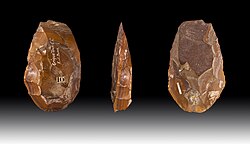Griquastad

History
In 1801 William Anderson and Cornelius Kramer, of the London Missionary Society, established a station among the Griqua at Leeuwenkuil. The site proved too arid for cultivation. In about 1805 they moved the station to another spring further up the valley and called it Klaarwater. Their second choice was little better than their first, and for many years a lack of water prevented any further development. The name of the settlement was changed later to Griquatown or Griekwastad in Afrikaans. They lived among a mixed nomadic community of the Chaguriqua tribe and "bastaards" (people of mixed origin) from Piketberg. Their two leaders Andries Waterboer and Adam Kok II later had a dispute and Kok left for Philippolis.
From 1813 to 17 July 1871, the town and its surrounding area functioned as Waterboer's Land. Waterboer himself lived in a "palace", which in reality was a house with six rooms. A monument for Waterboer was later erected near the town's hospital.
Robert Moffat and his wife Mary Moffat, on their way to the town of Kuruman, were residing in Griquatown when their daughter, also Mary (later Mrs. David Livingstone), was born in 1821. There is now a museum that is dedicated to her rather than the founder of the town, William Anderson.
That Griekwastad was later the capital of British Colony Griqualand West from 1873 to 1880, with its own flag and currency, before it was annexed into the Cape Colony. During the Apartheid era from 1969 till 2001, it was the garrison of the 4 Armoured Regiment, an SADF Tank Battalion equipped with Eland Mk7 Tanks.
Nowadays, the town is best known for the semi-precious stones found there, particularly tiger's eye and jasper. Sheep farming occurs with dorpers, a South African breed, which can now be found in places such as Australia.
Crime
On 6th April 2012 (Good Friday), Griekwastad farmer Deon Steenkamp (44), his wife Christelle (43) and their daughter Marthella (14) were killed. Later, Marthella was also found to have been raped during the last 24 hours of her life. Eventually the family's sole survivor, fifteen-year-old Don Steenkamp, who stood to gain a sizable inheritance, was suspected and accused of murdering his father. In 2014, he was found guilty of the murders, of raping his sister and of lying to the police and sentenced to twenty years imprisonment.
References
- ^ Robson, Linda Gillian (2011). "Annexure A" (PDF). The Royal Engineers and settlement planning in the Cape Colony 1806–1872: Approach, methodology and impact (PhD thesis). University of Pretoria. pp. xlv–lii. hdl:2263/26503.
- ^ "Main Place Griekwastad". Census 2011.
- ^ Distances from Griekwastad
- ^ "Moffat, Robert (1795–1883), missionary in Africa and linguist". Oxford Dictionary of National Biography (online ed.). Oxford University Press. 2004. doi:10.1093/ref:odnb/18874. ISBN 978-0-19-861412-8. Retrieved 2020-03-25. (Subscription or UK public library membership required.)
- ^ "British Empire: The Map Room: Griqualand West". britishempire.co.uk. August 27, 2007.
- ^ "Griekwastad teen to inherit R23m". News24. 2013-04-24. Retrieved 2020-03-25.
- ^ "Meet Don Steenkamp, the Griekwastad killer". News24. 2014-08-15. Retrieved 2022-05-29.
